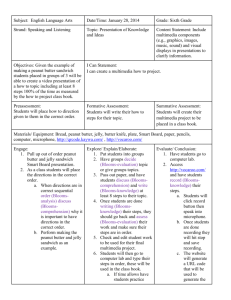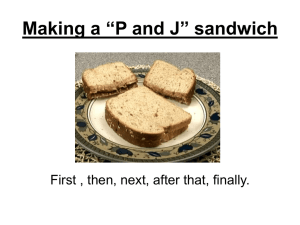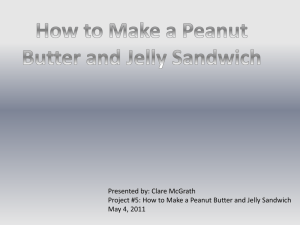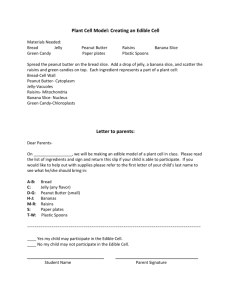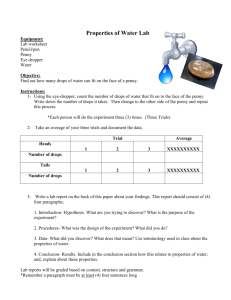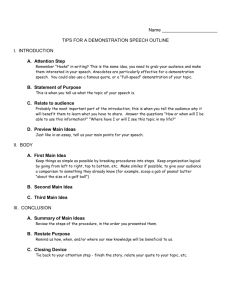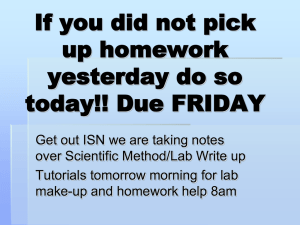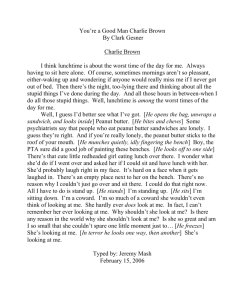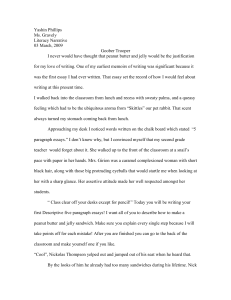Biology Partnership - Gulf Coast State College
advertisement
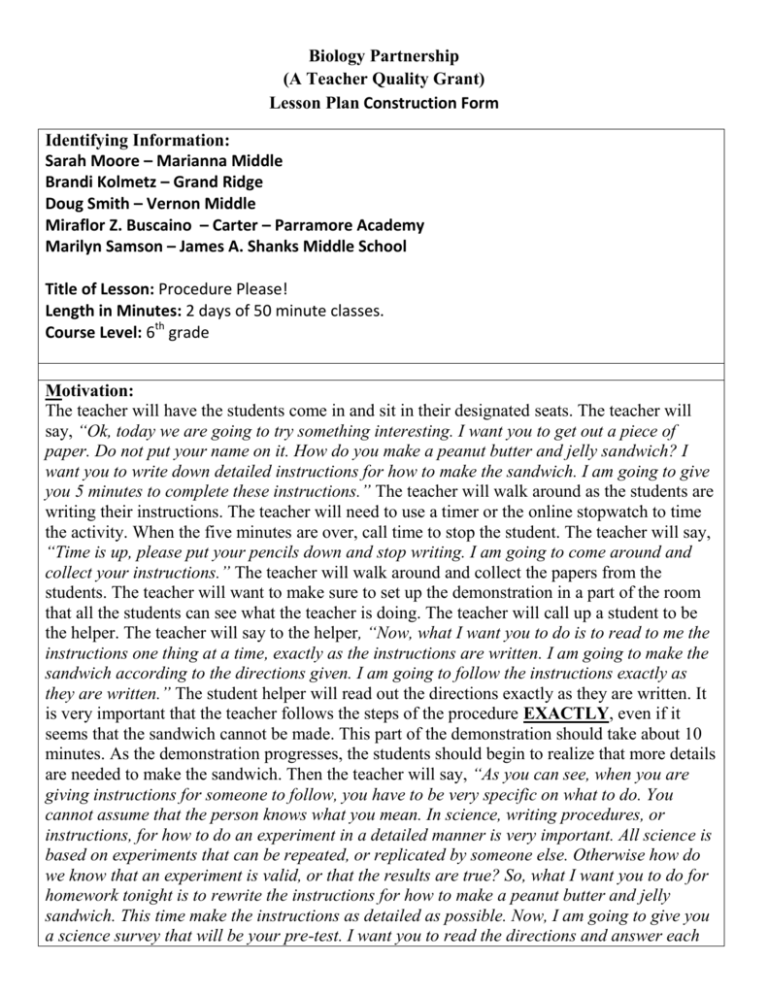
Biology Partnership (A Teacher Quality Grant) Lesson Plan Construction Form Identifying Information: Sarah Moore – Marianna Middle Brandi Kolmetz – Grand Ridge Doug Smith – Vernon Middle Miraflor Z. Buscaino – Carter – Parramore Academy Marilyn Samson – James A. Shanks Middle School Title of Lesson: Procedure Please! Length in Minutes: 2 days of 50 minute classes. Course Level: 6th grade Motivation: The teacher will have the students come in and sit in their designated seats. The teacher will say, “Ok, today we are going to try something interesting. I want you to get out a piece of paper. Do not put your name on it. How do you make a peanut butter and jelly sandwich? I want you to write down detailed instructions for how to make the sandwich. I am going to give you 5 minutes to complete these instructions.” The teacher will walk around as the students are writing their instructions. The teacher will need to use a timer or the online stopwatch to time the activity. When the five minutes are over, call time to stop the student. The teacher will say, “Time is up, please put your pencils down and stop writing. I am going to come around and collect your instructions.” The teacher will walk around and collect the papers from the students. The teacher will want to make sure to set up the demonstration in a part of the room that all the students can see what the teacher is doing. The teacher will call up a student to be the helper. The teacher will say to the helper, “Now, what I want you to do is to read to me the instructions one thing at a time, exactly as the instructions are written. I am going to make the sandwich according to the directions given. I am going to follow the instructions exactly as they are written.” The student helper will read out the directions exactly as they are written. It is very important that the teacher follows the steps of the procedure EXACTLY, even if it seems that the sandwich cannot be made. This part of the demonstration should take about 10 minutes. As the demonstration progresses, the students should begin to realize that more details are needed to make the sandwich. Then the teacher will say, “As you can see, when you are giving instructions for someone to follow, you have to be very specific on what to do. You cannot assume that the person knows what you mean. In science, writing procedures, or instructions, for how to do an experiment in a detailed manner is very important. All science is based on experiments that can be repeated, or replicated by someone else. Otherwise how do we know that an experiment is valid, or that the results are true? So, what I want you to do for homework tonight is to rewrite the instructions for how to make a peanut butter and jelly sandwich. This time make the instructions as detailed as possible. Now, I am going to give you a science survey that will be your pre-test. I want you to read the directions and answer each question.” The teacher will pass out the pre-test (attached). The students should be given 5 minutes to complete the pre-test. After the students have completed the pre-test the teacher will take it up. Then the teacher will say, “I want everyone’s complete attention. Today we are lucky, we have a guest speaker here today to talk to us about the importance of having detailed procedures and how following procedures affects their work. Please be courteous and listen to our speaker. Hold all questions until the end, and I am sure that they will be glad to answer any of your questions.” The teacher will then introduce the guest speaker, who should be a person in the community that has to follow very specific procedures to do their jobs. Suggestions could be an OSHA Coordinator (you can find these people at any industrial workplace), or a lab scientist. Then the guest speaker will start talking to the class about their job and the importance of having and following specific procedures in order to do their jobs. Needed Materials & Set-Up: Motivation Materials – Day 1 Peanut Butter (any brand, preferably creamy) Jelly (any brand) Bread in plastic loaf Plastic utensils (knife, spoon) Clean-up supplies (disinfectant wipes, paper towels, etc.) Paper Pencil/Pen Laptop with projector Seat Chart Copies of Pre-test/post-test (attached) For the motivation activity, the teacher is going to demonstrate only one peanut butter and jelly sandwich, so they will only need enough of the bread, peanut butter, jelly, knife/spoon materials to make one sandwich per class that is doing the lesson. Guest Speaker – Day 1 This speaker should be an engineer, scientist or any career person that uses procedures on a daily basis. Lab Materials – Day 2 Assortment of pennies (one penny per group) Dawn ® Dish Soap (a small amount in a cup per group) 50 Plastic pipettes (one per group, you want to have extras in case there are losses or damages) Plastic cups or beakers (should hold at least 100 ml) (one for the dish soap and one for water for each group) Paper Towels (1 or 2 per group) Water (a small amount in the a cup per group) Miscellaneous Materials Independent Investigations Worksheet (attached) (one per group) Independent Investigations Guidelines Worksheet (attached) (one per group) Both of these worksheets can also be copied from a link provided on this website: http://sciencespot.net/Pages/classgen.html#Anchor3 When getting on the site, click the link that says: Scientific Method Unit and Safety Rules. After you click that link, then scroll down until you see the bolded title: Independent Investigations. Both of these worksheets are able to be downloaded as PDF files, however, both worksheets are provided here as PDF files as well. When student come in the teacher should already have the students assigned to groups of 4 using the seating chart (attached). The seats should be arranged in pods of four, or if the teacher has tables instead of desks, then each table should contain 4 students. On Day 1 as the students come into the room they will go to the desks that the teacher assigns them. They will sit in this grouping as they perform the motivation task. The motivation task is done on an individual basis, however, the grouping on day 1 will make day 2 run smoother. After the motivation activity, the students will stay in their seats to listen to the guest speaker. On day 2 students will report back to their assigned groups for the presentation activity, which will be conducted in groups. Outcomes Dimensions of K-12 Science Education Standards: Dimension 1: Scientific and Engineering Practices 1. Asking questions (for science) and defining problems (for engineering) 3. Planning and carrying out investigations 6. Construction explanations (for science) and designing solutions (for engineering) 8. Obtaining, evaluating, and communicating information Dimension 2: Crosscutting Concepts 2. Cause and effect: Mechanism and explanation 6. Structure and function Dimension 3: Disciplinary Core Ideas PS 1: Matter and its interactions PS 2: Motion and stability: Forces and interactions ETS 1: Engineering design Content Literacy Standards: Reading Standards – Integration of Knowledge and Ideas Writing Standards – Research to Build and Present Knowledge Speaking and Listening – Comprehension and Collaboration, Vocabulary acquisition and use. Next Generation Sunshine State Standards SC.6.N.1.1 – Students will define a problem from the sixth grade curriculum, use appropriate reference materials to support scientific understanding, plan and carry out scientific investigation of various types, such as systematic observations or experiments, identify variables, collect and organize data, interpret data in charts, tables, and graphics, analyze information, make predictions, and defend conclusions. SC.6.N.1.4 – Students should discuss, compare, and negotiate methods used, results obtained, and explanations among groups of scientists conducting the same investigation. Specific Learning Outcomes: 1. After watching a demonstration of the teacher making a peanut butter and jelly sandwich by following instructions the students will write steps for how to make a peanut butter and jelly sandwich with at least 10 detailed, accurate steps. 2. Given the process of brushing teeth, students will practice writing procedures for this process in 10 detailed, accurate steps. 3. Using the Independent Investigation Guidelines and Independent Investigation worksheets students will develop procedures to conduct the experiment with at least 80% correct steps. The teacher will tell the students the outcomes expected for this lesson prior to teaching. The students‟ achievement will be measured by evaluating the Independent Investigation Worksheets, the directions for making the peanut butter sandwich, and the directions for brushing teeth (Pre-test / Post-test) that students are to turn in. Presentation and Participation: INSTRUCTIONAL STRATEGY Behavior : demonstration, lecture, modeling, discussion, cooperative learning, creating lists Cognitive : concept mapping, simulations, role playing, summarizing & note taking, conversations, thinking activities, using analogies Application/Process : information management, advance organizers, inquiry based, seeking out answers to questions, testing hypothesis, problem solving Other Strategies – homework, practice, providing feedback, questioning, setting learning goals Day 1- 50 Minutes When students first walk in they will need to go to the assigned seat that the teacher directs them to. The teacher will perform the motivation activity that is listed above in this lesson plan. The motivation activity and pre-test should not take more than 20 minutes to do. After the motivation activity, the students will listen to a guest speaker talk to them about procedures. The Speaker will speak for 30 minutes about how they use procedures in their job. This will teach the students about the reasons/ways procedures are used in the „real‟ world. When students make personal connections they learn on a higher concrete level. Day 2 – 50 Minutes When students first walk in they will need to go back to their assigned seats to begin working as a group. The teacher will need to take up the homework that was assigned the night before. This is the assignment where students had to go home and write a more detailed procedure for making a peanut butter and jelly sandwich. What the teacher is looking for is that they were able to accurately list 10 or more detailed steps. When the homework is handed in the teacher will hand out the Independent Investigation and Independent Investigation Guideline worksheets. The teacher will say, “Today you are going to perform an investigation with a penny and water. I am going to give you a question and you are going to have to answer that question. In order to do this, you will have to design an investigation to test what you think the answer is. This is your hypothesis. Remember, just like with the peanut butter and jelly sandwich directions, it is important to write your procedures for how to do an investigation very specifically, and what you found when you did the experiment. The reasoning behind this is because in science, in order for an experiment to be valid it has to be able to be repeated and replicated. You should be able to follow your steps and perform the experiment again with similar results. Also, someone else should be able to perform your steps and also achieve similar results. You are going to be working in the groups that I sat you in.” At this point the teacher should pass out the materials for the penny lab. (See materials list). After the materials are passed out the teacher will say, “Now that you have the materials in front of you the question is this: How many drops of water will stay on a penny? You will need to talk as a group and determine your idea of how many drops of water can you drop on a penny before it spills over the penny and onto the paper towel. After you have discussed what you think, then you will need to design your experiment to test your hypothesis. This is where you will use the Independent Investigation worksheet to record your procedures and the Independent Investigations Guidelines worksheet to give you a little guidance on how to help with that. I will walk around and offer some guidance, but I want you to work together and figure out how to write what you did in your lab so that anyone else who reads it could perform the same experiment and get similar results. I will take the worksheets up when time is up. You will have 45 minutes to do this activity.” The teacher will walk around and watch as students work on writing and performing their experiment. They should help them if needed. What the teacher is looking for is students being able to predict how many drops they think will fit on the penny and then writing down a plan to test that hypothesis. After they test it, then they need to be able to analyze their data and see if they need to redo their hypothesis and retest it. What is most important for this investigation is not the lab, but can the students accurately write down a procedure for doing a lab. Once the 45 minutes is up, the teacher should collect the procedure worksheets from each group. After the activity the teacher will need to hand out the post-test and have the students complete this. They will have about 5 minutes to do this. The students may be working on one activity for 45 minutes, however, the nature of the activity is that the writing and testing of the procedure will alter and vary their activity constantly during those 45 minutes. Teachers will be able to use the procedure sheets from the activity to see if they understood the concept of being able to accurately write a procedure for their experiment. They should be able to accurately complete 80% or better for this task. The teacher will also be able to use the homework assignment for an assessment piece. The students should be able to complete at least 10 detailed steps accurately. The last piece of evaluation that the teacher has is the pre and post-tests. The students should be able to show improvement from the pre-test to the post-test. Questions: (3 higher order—analysis, synthesis, evaluation) 1. What is a procedure? 2. How you would compare the instructions that you wrote the first time for making the peanut butter and jelly sandwiches to the second set of instructions that you wrote? 3. How would you apply what you learned to develop other experiments? Explain and justify your reasoning? 4. What conclusions can you draw as to the importance of detailed procedures? Explain and justify your answer. 5. How would you improve the way that you give directions, instructions, or procedures not only for the science experiments, but also in real life? Explain and justify your answer. 6. How would you prioritize what steps should come first in your procedures? Explain and justify your answer. Reflection: Discussion Questions from the Activity: 1. Compare your results to the results of your classmates. Did everyone in the class get the same results? Why or why not? 2. What type of things might have been changed from group to group to cause the differences in data? 3. What could we have done to make sure all the groups ended up with similar results? 4. What is the control for this experiment? What is the independent variable? What is the dependent variable? 5. How would you change this experiment if you are able to do it again? The teacher will have the students write down their answers and write feedback to them like in a response journal. Full points will be awarded to students who answer the questions honestly, accurately and fully. Most of the questions are subjective, but they have to give full and complete answers. Administer the post test (same as the pretest) The teacher will write on the board a detailed list of procedures for brushing teeth to demonstrate how specific the directions should be. Those who did not get 80% mastery of the post-test, have the students write their own procedures on the following situations: How to make paper airplanes How to upload music on your IPod. Have the students compare their procedures with their classmates and the teacher will choose the best procedure based on the clarity of the steps to be followed. Safety: http://sciencespot.net/Media/pennylab.pdf • The laboratory safety rules are posted on the wall. Safety rules should have already been discussed in the classroom prior to this lesson. There will be discussions to remind the students before the activity for them to follow. Emphasis will be on the following safety rules: • Always wear safety goggles when experimenting with chemicals (soap). • Never taste chemicals (or other substances) used for a lab experiment. • Keep lids on all containers when not in use. • Clean up spills immediately. • If any substance gets into your eyes or in a cut on your skin, notify your teacher and follow his/her directions. • Wash your hands before and after an experiment. • Clean up your lab area and materials after an experiment and return materials to their proper location. (You might also want to emphasize that eyedroppers are not to be used as mini water guns!) Transformative: (Accommodations for at least 3 special needs students) A. ELL student Teach vocabulary Monitor comprehension Extra time to complete assignments Ask higher level questions frequently Assistance with instructional activities Modified written instructional materials Encourage use of graphic organizers and drawings Limit number of problems/questions according to proficiency B. ESE students Monitor comprehension Extra time to complete assignments Ask higher level questions frequently Assistance with instructional activities Promote cooperation with small groups Encourage use of graphic organizers and drawings Focus on thinking skills (predict, classify, observe…) C. Low Achievers Give daily evaluations. Give extra time to finish assignments. Use simple vocabulary in directions and instructions. Use standard formats and limited types of responses for each assignment. Utilize: Part A: Closure: (exit card) Have students write a question or a statement about what had been discussed in the lesson. Encourage them to post information that they either have questions on, need clarification on, or really understand, on the Question and Answer Board that has three categories: I GOT THIS, I NEED CLARIFICATION ON THIS, and I GOT NO CLUE ABOUT THIS. All statements or questions posted will be discussed the next day. This will be one of the bases if the teacher needs to remediate or elaborate further on the lesson. Key Concept summaries for the Presentation Activity: When you place water drops on a penny, the drops pile up into a small dome. Why? Because water molecules are attracted to each other in all directions making them “stick” together. However, the molecules at the surface “stick” only to the molecules next to and below them. That‟s because there are none above them. This makes the surface act as if it had a thin “skin.” This is called surface tension. As you add more drops, the force of gravity becomes stronger than the force of attraction among the water molecules at the surface. This causes the water to spill over the edge of the coin. Part B: (Homework) The teacher should then re-assign the “How Do You Make a PB&J Sandwich?” Procedure writing assignment as homework. Strengths: If students can write the procedures very well, they should be able to follow any other directions that they are given in any class or outside situation as well. Challenges: The biggest challenge that students will face with this lesson is being able to write detailed instructions and procedures. They will need to have practice all throughout the year in reading, following and writing procedures. penny, the drops pile up into a small Part C: (Re-teaching) http://wwwtc.pbskids.org/zoom/printables/activities/pdfs/penny.pdf Now it‟s time for you to write your own procedure and experiment. What happens if you use a different coin, like a nickel, a dime, or a quarter? Use what you know about a penny to predict how many drops will fit on a different coin. What happens if you mix soap with the water and then add the drops? Choose one thing to change (that‟s the variable) and make a prediction. Complete the table below. My Trial 1 Trial 2 Trial 3 Trial 4 Average Prediction Number of Number of Number of Number of Number of drops drops drops drops drops Penny Dime Nickel Quarter
